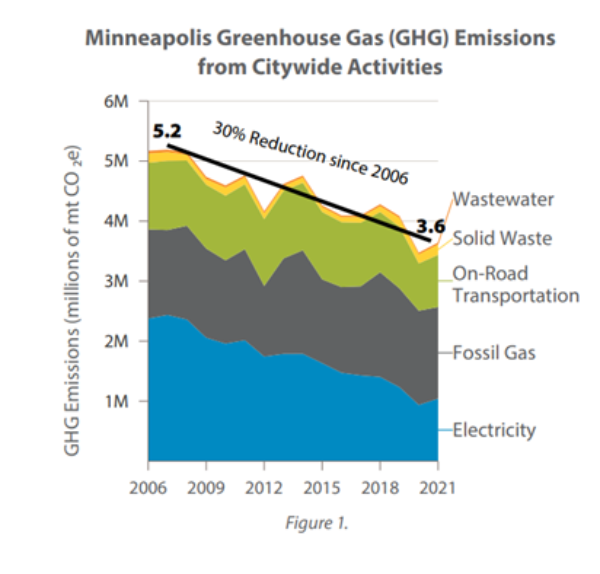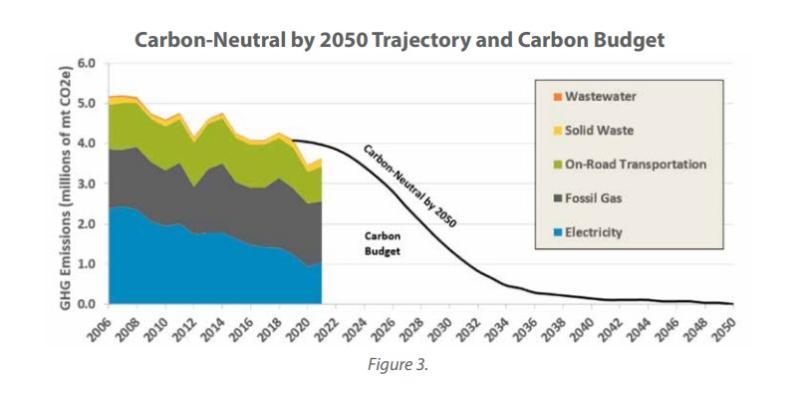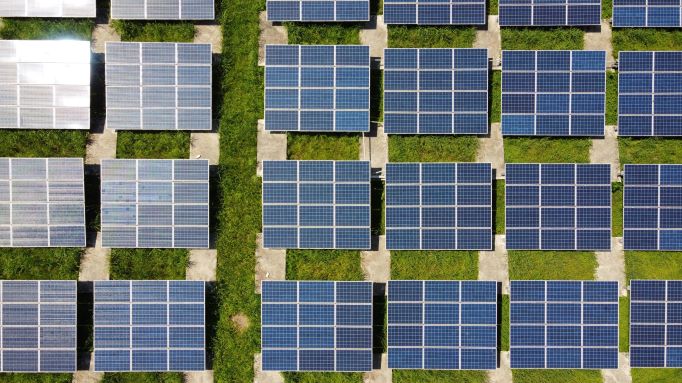A cornerstone of the 2023 Climate Equity Plan recently adopted by the City Council and Mayor Jacob Frey centers around the goal of achieving net zero greenhouse gas emissions in Minneapolis by 2050.
Minneapolis is part of the United Nations-backed Race to Zero campaign – a global coalition of cities, states, regions, companies and institutions committed to taking immediate action to achieve carbon neutrality by 2050 at the latest.
Where are we now?
Citywide greenhouse gas emissions have decreased 30% compared to the 2006 baseline.
Citywide greenhouse gas emissions include five sources:
- the use of electricity,
- the combustion of fossil gas in buildings,
- use of gasoline for on-road transportation,
- the disposal of solid waste, and
- the disposal and cleaning of wastewater from buildings.
For the fifth year in a row, fossil gas was the largest source of greenhouse gas emissions in Minneapolis in 2021 at 42%, followed by electricity (28%) and on-road transportation (24%). Nationally, on-road transportation and electricity generation are the largest source of greenhouse gas emissions.

Accelerated action needed
Achieving net-zero greenhouse gas emissions in Minneapolis by 2050 will take accelerated action steps by the City and partners.
The Minneapolis Clean Energy Partnership includes the City of Minneapolis, the city’s electric utility Xcel Energy and gas utility CenterPoint Energy. The partnership focuses on advancing the City’s climate goals.
CenterPoint Energy has a net-zero carbon emission goal by 2035, and Xcel Energy has pledged to be a net-zero energy provider by 2050.
“In order to accelerate our work, we’ve got to be able to collaborate with government partners, community groups, neighborhood groups, and City departments. Working together we will be able to achieve our climate goals in an environmentally just way,” said Kim Havey, the City’s director of sustainability. “Secondly, we want to build up our staff capacity to manage new programs that take a systemic and comprehensive approach to reducing emissions from our homes and commercial buildings.”

Biggest source of emissions
In Minneapolis, most carbon pollution is created by heating, cooling and lighting our buildings. Many of our buildings are old and energy inefficient. The Climate Equity Plan includes a goal of equitably reducing greenhouse gas emissions from the industrial, commercial and multi-family residential building sector by 75% by 2030.
In 2021, buildings in Minneapolis produced about 2.5 million tons of greenhouse gases with about 65% of the emissions coming from commercial, multifamily and industrial buildings. From all the buildings, 60% of the emissions are from fossil gas and the rest are from electricity.
One way the City is addressing building emissions is through the City’s Energy Benchmarking Program, which tracks electric and gas use of commercial and residential buildings over 50,000 square feet. Energy evaluations are free and required for buildings that get an Energy Star score of 25 or less or are on the list of low-performing buildings.
The City also offers the Green Cost Share Program, which provides financial assistance to help community members complete energy efficiency, solar and air pollution projects.
The City of Minneapolis is also leading by example with its Sustainable Building Policy, which requires all new City owned and operated buildings use 80% less carbon compared to the same structure built in 2026. The City has also set a goal of achieving net zero greenhouse gas emissions for all new buildings by 2030.

Top priorities moving forward
Implementing the City’s Climate Legacy Initiative is the top priority as work begins to implement the City’s ambitious Climate Equity Plan.
The Climate Legacy initiative will generate $10.2 million annually for the City’s climate action work through increases in the utility franchise fee in Minneapolis, rates paid on customer energy bills. The additional funding will triple the budget for climate work at the City.
Additional top priorities moving forward include:
- Working with large property owners in Minneapolis on the Green Cost Share Program to assist with implementing energy audit recommendations.
- Piloting an affordable housing energy efficiency program for one- to four-unit homes to weatherize and install new heating and cooling systems in addition to removing lead and asbestos from the homes.
- Updating City code to allow for growing of edible plants on boulevards.
- Increasing tree planting throughout Minneapolis. The City recently received an $8 million grant from the U.S. Department of Agriculture’s (USDA) Forest Service’s Urban and Community Forestry Program for its Equitable Tree Canopy Management Program.
Leading cities on the path to carbon neutrality
While no city in the world has achieved carbon neutrality, Scandinavian cities are among the most aggressive on charting a course toward zero emissions.
Oslo, Norway has one of the most ambitious goals and pledges to cut emissions 95% by 2030 compared to 2009. The city’s climate strategy includes a climate budget that puts the city’s climate goals at the center of its budgeting process and brings specificity to implementing its goals.
Oslo and other Scandinavian cities are leaders in decarbonizing district energy systems that heat and cool residential and commercial buildings.
That’s one of the biggest challenges for Minneapolis – figuring out how to reduce emissions from heating and cooling homes and buildings. “The biggest nut to crack is reducing our fossil gas emissions,” Havey said.
To take on this challenge of reducing gas emissions from heating, the City of Minneapolis is partnering with CenterPoint Energy to pilot a carbon capture technology that can captures up to 50% of the carbon emissions from a gas furnace or boiler and uses the byproduct to create soap. The company that has pioneered this technology, CLEANO2, is installing this carbon capture in a number of City buildings and other institutions in Minneapolis such as the Minnehaha Academy. With positive results from these pilot projects, the City plans to expand the use of this technology throughout Minneapolis.
To learn more about the City of Minneapolis Climate Equity Plan, visit the City’s website.


